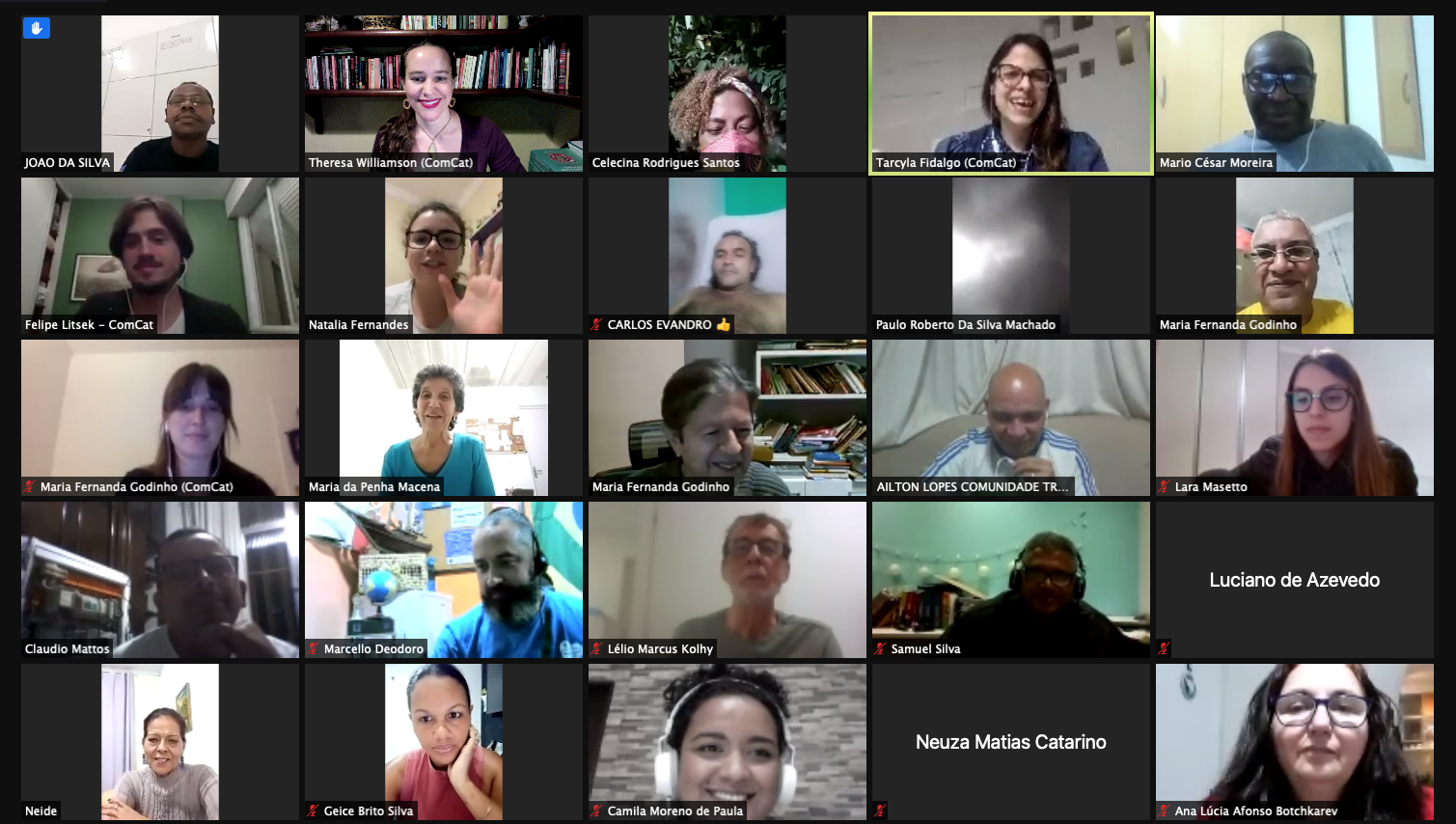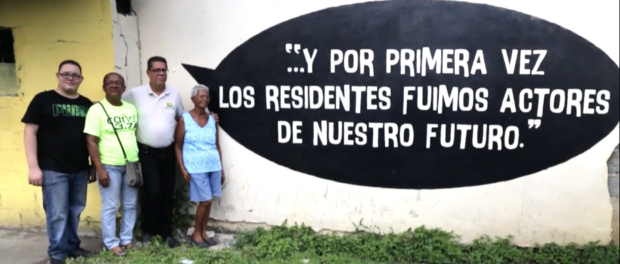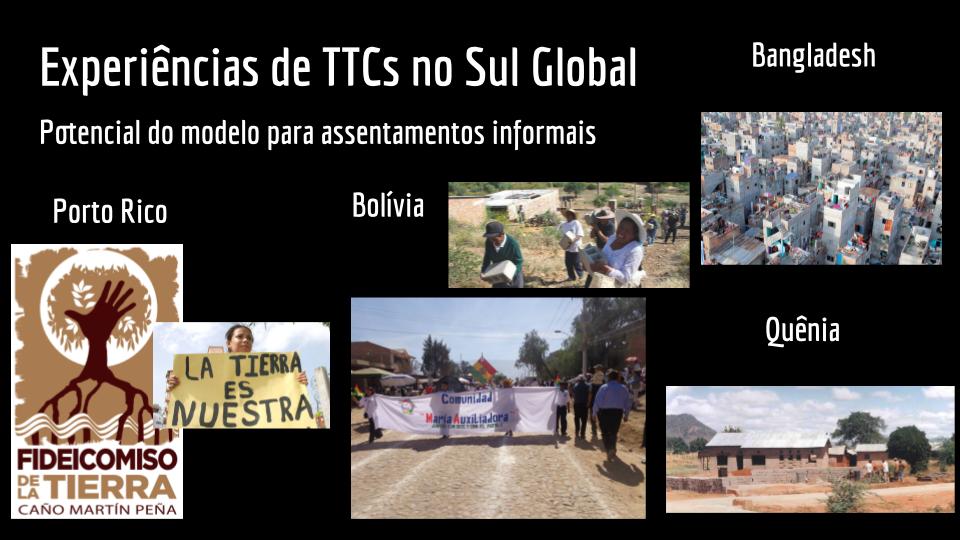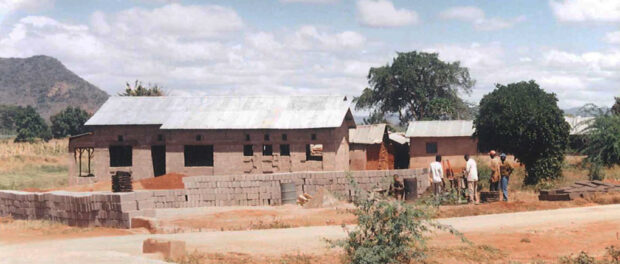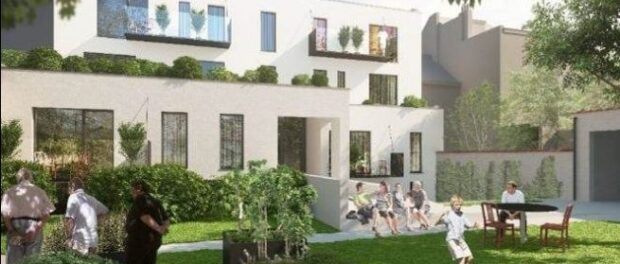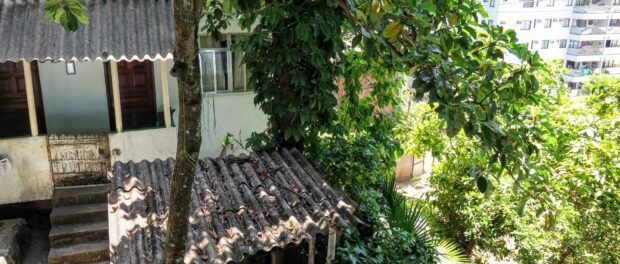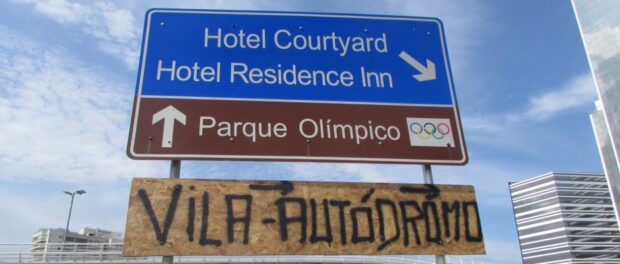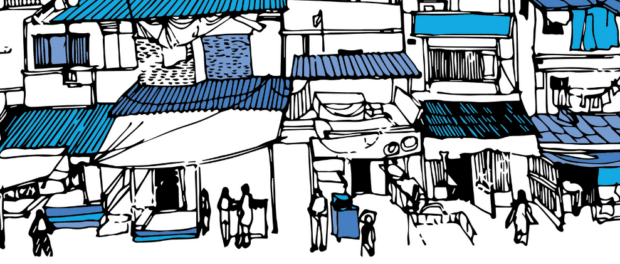
This is the second of two articles covering the Favela Community Land Trust National Seminar. Read the first part here.
Continuing the Favela Community Land Trust (CLT)* National Seminar, facilitated by Catalytic Communities (CatComm), the online sessions on the second and third days—June 23 and 24—addressed the historical context of the CLT’s creation as a modality of collective property and guarantee of permanence of vulnerable communities. Starting with an analysis of international experiences of Community Land Trusts, the typical structures of all CLT were described so that participants could then discuss their potentialities, challenges, and applicability to Brazilian favelas.
These discussions were realized by CatComm executive director Theresa Williamson, Favela CLT coordinator Tarcyla Fidalgo, and four community leaders from Rio de Janeiro: Paulo Roberto da Silva Machado and Ailton Lopes, representatives of the Residents’ Association of the Trapicheiros community, in Tijuca; Neide Mattos, from Conjunto Esperança, in Colônia Juliano Moreira, Jacarepaguá; and Maria da Penha Macena, resident of Vila Autódromo and leader of the Evictions Museum, near Barra da Tijuca. In addition, representatives of CLTs from the Puerto Rico and United States participated by means of videos sent especially for the seminar.
Examples of CLTs Around the World
 Starting her presentation, Williamson described how the first CLT emerged over 50 years ago from the mobilizations of the African-American civil rights movement in a historical context of struggle for housing and land in the United States. This first CLT was called New Communities and is located in Albany, Georgia. Being a rural CLT, it was founded by the community that collectively acquired 3000 acres of farmland and 2000 acres of woodland. At the time, it was the largest plot of land owned by African Americans in the United States.
Starting her presentation, Williamson described how the first CLT emerged over 50 years ago from the mobilizations of the African-American civil rights movement in a historical context of struggle for housing and land in the United States. This first CLT was called New Communities and is located in Albany, Georgia. Being a rural CLT, it was founded by the community that collectively acquired 3000 acres of farmland and 2000 acres of woodland. At the time, it was the largest plot of land owned by African Americans in the United States.
 The Dudley Neighbors Initiative CLT in Boston, Massachusetts, is another successful example from the US described at the Seminar. Founded in 1988 by a diverse community organization, it organizes housing construction and develops projects for the neighborhood. The Dudley Street Neighborhood Initiative initially faced legal barriers and political mistrust, yet thrived and is today an example that shows the potential of CLTs to stimulate community development not only for housing, but for recreation, culture, and food.
The Dudley Neighbors Initiative CLT in Boston, Massachusetts, is another successful example from the US described at the Seminar. Founded in 1988 by a diverse community organization, it organizes housing construction and develops projects for the neighborhood. The Dudley Street Neighborhood Initiative initially faced legal barriers and political mistrust, yet thrived and is today an example that shows the potential of CLTs to stimulate community development not only for housing, but for recreation, culture, and food.
CLTs today are a globally recognized affordable housing solution. The 2017 New Urban Agenda highlighted CLTs as one of the instruments that should be privileged and encouraged by UN member states, and CLTs are today widespread in several countries, and present on all continents. There are 280 CLTs across the US; in Europe there are 300 in the UK, eight in Belgium, 20 in France and recently one in Germany. In Canada there are 24, and in Australia, three. In the Global South, we see examples flourishing in Puerto Rico and Kenya, and seeds in Bolivia and Bangladesh.
“Our [Brazilian] case uses Puerto Rico as a model. In San Juan, eight existing favelas decided to retrofit the CLT model to their circumstances. It is important to highlight that in the US, CLTs have proven the most robust affordable housing solution, ensuring the permanence of residents both in periods of economic recession, which typically generate evictions by foreclosure, and during economic booms, when there is a risk of gentrification due to real estate speculation. For us, here in Rio, during the Olympics, we saw simultaneous evictions and gentrification in the favelas,” said Williamson.
The Fideicomiso de la Tierra Caño Martín Peña CLT, in Puerto Rico, comes closest to the Brazilian reality. It was built by residents from the eight communities along the Martín Peña Canal in San Juan over the last nearly 20 years, bringing together over 2,000 favela residents who adopted the model of collective management of legalized land.
Surface rights were used as a tool to separate the land from the buildings on it, whereby the community collectively owned the land via the CLT, while residents owned their homes. This formula kept the land from being lost to speculative pressures and gentrification, removing it permanently from the market. Meanwhile, other challenges remain for these San Juan favelas: flooding of the canal neighboring the communities of the Caño Martín Peña is frequent, and the storms and hurricanes that hit Puerto Rico annually, such as Irma and Maria, are devastating to the communities. But thanks to their legalization and highly organized and united CLT, and with support networks both internally and with other CLTs across the world, the communities of Caño Martín Peña have been more able to deal with these challenges than most.
The success of this CLT shows the strength of the model for favelas and other informal settlements around the world, guaranteeing the permanence and security of tenure of residents in the face of economic power while simultaneously ensuring that the residents themselves define their own direction and development. Because they are collective owners of the land, they have greater bargaining power with the city government, being large landowners in the city center. “[The Martín Peña CLT] makes residents owners of their land, and also allows them to have a lot more power with the city administration,” explained Williamson.
Moving on to Africa, Fidalgo presented the Tanzania-Bondeni CLT in Kenya. Originally informal, this is a settlement where approximately 3000 people have lived for over 30 years in extreme poverty and with lack of access to basic resources such as health, water, and electricity. When it was set up, the CLT experienced challenges such as legislative hurdles and internal issues like rules being broken, problems with representation, and mistrust.
“The Kenyan experience shows us that setting up a CLT is not enough; a mature community movement and effective collective management mechanisms are needed. But despite this, the CLT played an important role in extending public services and protecting against evictions,” said Fidalgo.
Among the CLTs in Europe, the Brussels CLT (CLTB), in Belgium, was described. Having emerged during the Brussels housing crisis of the 2000s, it was only formalized in 2012, and received the support of public authorities for its creation—especially in the form of loans for land acquisition and technical advice.
One of the main challenges faced by this CLT is that it remains dependent on public investment for the maintenance of the properties. With ample financial support from the Sustainable Housing for Inclusive and Cohesive Cities (SHICC) fund, as well as from the Brussels City Council—which has committed to funding CLTB operations, subsidizing investments for land acquisition and construction—the Brussels CLT has been maintained and expanded. The European Union has also committed to funding specific CLTB projects, such as the Caring and Living in Communities (CALICO) project, which plans to build 34 housing units with a €5 million (US$ 5.9 million) subsidy.
Because of this need for public funding, CLTB is vulnerable to political changes, besides running the risk of bureaucratization and government interference. Regardless, the Brussels CLT marked the introduction of the model in continental Europe, allowing several other initiatives to emerge since.
Another highlight from the Seminar’s evenings were the messages sent from partners from international CLT experiences. John Emmeus Davis, who has been a Community Land Trust activist for 40 years, said by video: “I am impressed by your work in Brazil, I congratulate you and hope you will follow through and make it happen!” Other big names, like Mario Nuñes from Puerto Rico and Tom Angotti from New York, also left testimonials and words of support.
Community Land Trust Structure
After the international CLT examples, Fidalgo explained the structure of the Community Land Trust model to participants interested in how it would work in practice. She explained that each CLT is unique, as it takes into account the needs of each location and its residents. “We are proposing a Community Land Trust model that is adapted to the specificities of Brazil, especially in the legal respect. Our model intends to guarantee security of tenure for vulnerable populations on a long-term basis. In short, the CLT is a model of organization and collective management of the territory that combines individual freedom with the strength of collectivity.” The goal of any CLT is to remove land from speculative pressures and strengthen community organizing efforts, ensuring affordable housing and the permanence of communities on their land, along with community-controlled development.
Regarding the structure of the CLT, the first point would be the establishment of a legal entity. Created by organizing residents and managed by them, this entity will be the formal owner of the land. The second point is the separation of land from the houses on it, with the land being owned by the legal entity created and managed by the residents, and the houses owned by their respective residents, using surface rights as the legal instrument to make this reality, already available within the Brazilian legal code.
The last point of this structure is, in fact, the implementation of the CLT. “The ideal situation is that the CLT is created along with a land regularization process. Internal rules should be defined by residents, registered in a land registry office, while community planning also takes place, inverting the top-down logic typical of public authorities… When comparing a traditional purchase and the Community Land Trust, we have the buyer being the owner of the house and of the land beneath it in the first one case, while in the CLT, the CLT owns the land and the house belongs to its resident,” said Fidalgo. She concluded, “from what we have studied, the potential of CLTs for favelas is huge.”
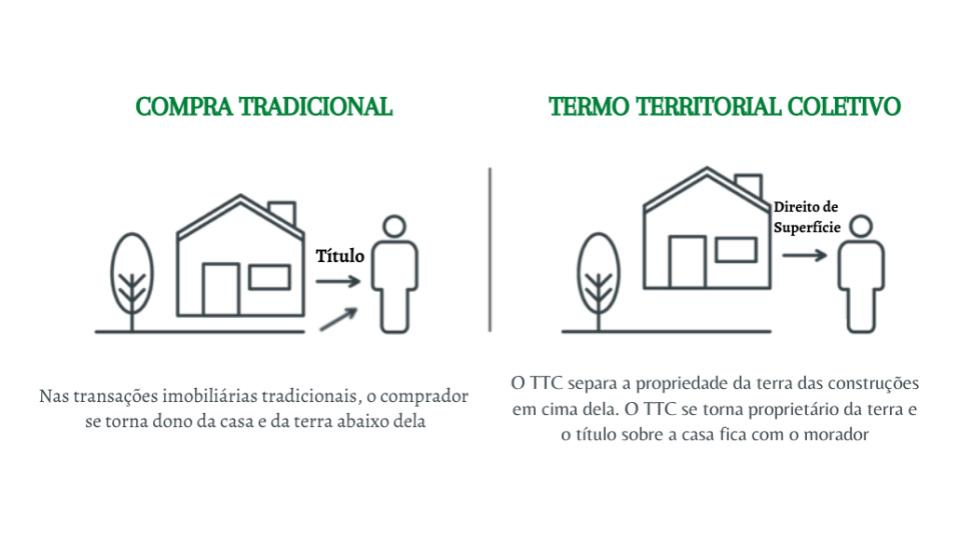
Challenges to Implementing CLTs in Brazil
One of the main challenges to the implementation of CLTs is the issue of individualism, which makes people think of real estate solely as individual private property. This stops them from having the sensitivity to realize the power of collective mobilization in ensuring many favela residents’ primary goal with land regularization: their permanence on that land. Fidalgo stressed that it is indeed a challenge, but that in the experience of the F-CLT Project in Rio, there are already good results in the sense of overcoming this individualistic logic. Disseminating the model to residents was also highlighted as a challenge due to its complexity. Fidalgo said, however, that “this is no reason to set it aside for a simpler solution. We have to look for the best solution for the communities.”
There was mention of misgivings for the model being international, and not Brazilian, to which Fidalgo replied: “It is important to say that the CLT is present in many countries, everywhere in the world. It is not an American or an English solution, it is an international solution, which is coming here as well. The CLT is a collective management model that has been successful for decades, in many places around the world.” Besides, the CLT was developed by activists in the civil rights movement, based on numerous international experiences previously studied by its founders.
The difficulty in mobilizing participants in recent years, especially since the pandemic began, was also highlighted. “It is difficult to keep the attention of residents, when they already have so much to worry about. But I repeat, this is only a moment, things will get better,” Fidalgo told the audience. As well as difficult community mobilization, there is the delay of the regularization processes, although “the CLT also helps with this because it helps pressure public authorities. Therefore, mobilization [by the CLT] and regularization should happen simultaneously, so that the two meet further down the line and the community has already been strengthened,” explained Fidalgo.
Some participants expressed concern that the armed groups that dominate some territories in Rio will not respect CLTs in favelas and their collective land management. Regarding the possibility of conflicts with militias and drug trafficking, Fidalgo said that “there is no easy answer, but I strongly believe that community empowerment tends to drive these groups away.”
Turning to the potentialities, many were mentioned: popular participation, the mitigation of gentrification, the guarantee of ownership, being a collective enterprise, the full development of a self-led community, innovation materializing constitutional rights, the construction of networks between CLTs, the possibility of support groups, the facilitation of a dialogue with government, the creation of a collective identity, the versatility of the model, the protagonism of residents, among others.
Rio Favela Organizers Interested in the Model
Residents of favelas and territories that are interested in establishing CLTs spoke about their struggles and experiences. Ailton Lopes, from the Trapicheiros community in Tijuca, began by saying how exciting it was to get to know the CLT when he had his first contact with it in 2018. “Since 2010, our community has been suffering threats of eviction, and the CLT is a perfect fit with our case. We did many workshops with the community to show what the CLT is all about. In my understanding, the CLT is a way to protect the community from forced evictions. It’s sensational.”
Paulo Roberto da Silva Machado, president of the century-old community of Trapicheiros, in the North Zone, continued by telling of his experience visiting the CLT in Puerto Rico: “I was able to visit the Caño Martín Peña CLT. It’s a community with an incredible history. The harmony with which they work is beautiful to see. I believe that we will see this here in Brazil in the near future. The fight won’t stop, we can’t give up.”
 Next, Neide Mattos talked about her experience in Conjunto Esperança, in the West Zone, where residents have been fighting for years to remain on their land, after building the community collectively through the Minha Casa Minha Vida-Entidades community-build public housing program. “We have been claiming our community’s land for ten years… we still have a lot of organizing to do. The CLT has a lot to contribute. We already have the structure, but we still need to formalize it. It is a pleasure to be speaking to all of Brazil. I hope that you can organize yourselves all over the country. People need housing.”
Next, Neide Mattos talked about her experience in Conjunto Esperança, in the West Zone, where residents have been fighting for years to remain on their land, after building the community collectively through the Minha Casa Minha Vida-Entidades community-build public housing program. “We have been claiming our community’s land for ten years… we still have a lot of organizing to do. The CLT has a lot to contribute. We already have the structure, but we still need to formalize it. It is a pleasure to be speaking to all of Brazil. I hope that you can organize yourselves all over the country. People need housing.”
With a moving testimony that inspired those present, Maria da Penha Macena told the story of the residents of Vila Autódromo’s fight to stay on their land during Rio’s pre-Olympic evictions, as well as her experience visiting the Cooper Square CLT in New York. “I had the opportunity to visit a CLT in New York and it was great to see another country’s experience. I just want to repeat how important the CLT is for our country, to secure our land. We have always been threatened with eviction. In Vila Autódromo, and with the mega-events, for the 2016 Olympics, we ended up having almost the entire community evicted. We are currently only 20 families. If we had the CLT [at the time], our community wouldn’t have been evicted.”
For more information or to become part of the F-CLT Project, visit the website here.
This is the second of two articles covering the Favela Community Land Trust National Seminar. Read the first part here.
Watch the Second Day of the F-CLT National Seminar Here:
Watch the Third Day of the F-CLT National Seminar Here:
*Both RioOnWatch and the Favela Community Land Trust (F-CLT) are initiatives of the NGO Catalytic Communities (CatComm).

